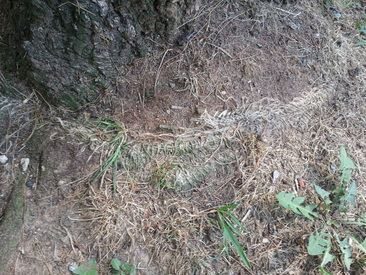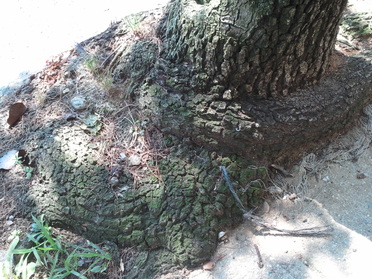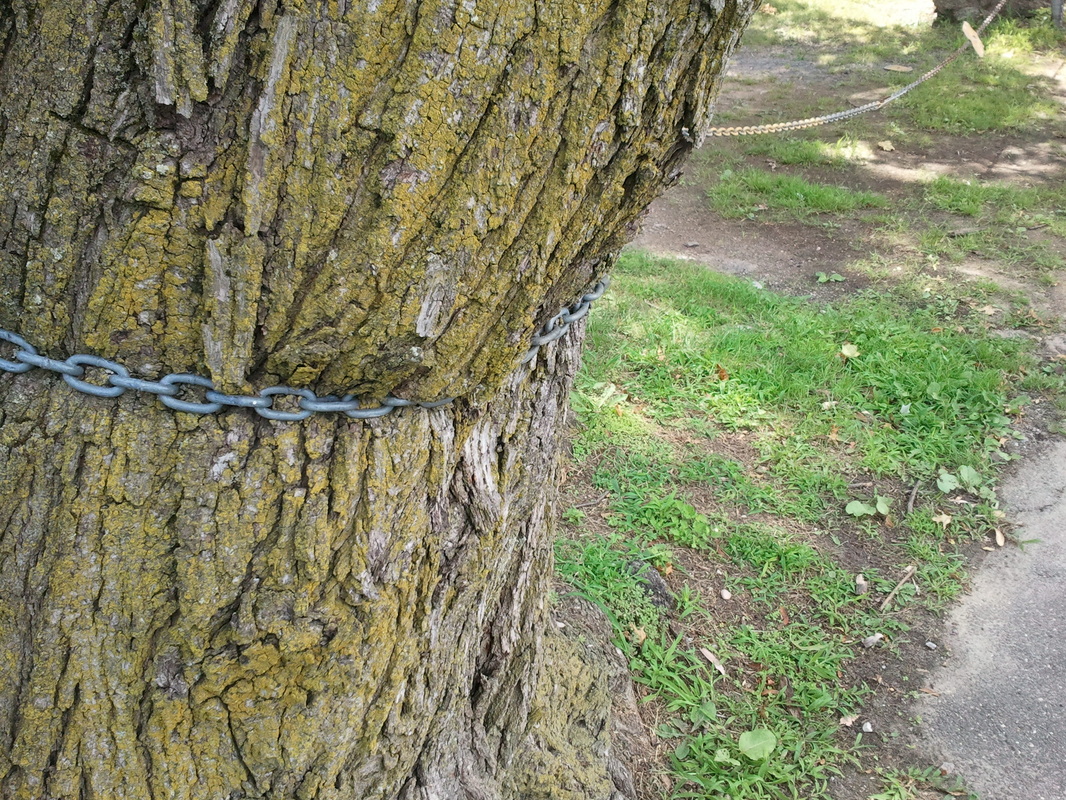We walked from New Rochelle's boundary with Pelham Manor along Pelham Road and up Weyman exploring all the side streets along the way and then back to Pelham Manor via Rockledge, Hillcrest and Mt Tom. Our big discovery was Donofrio Memorial Park! Tucked away at the end of MorganStreet behind the Home Depot and Costco it looks desperately underutilized and included the tree below, used to chain off an area and developing an unhealthily nipped in waist.
Happily at least some cities are beginning to realize the value of trees in their communities. Mesquite, Texas undertook an Urban Forest Ecosystem Analysis in 2012 and determined that their trees were worth 996 million dollars. Here's a few things Mesquite's Online News had to say.
"Most of the trees in the city are less than 6 inches in diameter but they provide the removal of 288 tons of pollution each year, store 145,000 tons of carbon and produce 31,900 tons of oxygen. The trees also provide building energy savings of $773,000 a year and approximately $2 million a year in savings through annual rainfall interception."
Mesquite has close to double the population of New Rochelle and covers 42.2 square miles to New Rochelle's 10.67 but it leaves me wondering about the worth of New Rochelle's trees and whether the city includes them in their accounting beyond the expense of maintenance of city owned trees.
Fayetteville in Arkansas completed an Urban Forest Ecosystem Analysis in 2002 and followed it with a Tree Canopy Assessment in 2012. Here's a short summary of findings:
"- Overall Tree Canopy Cover: Fayetteville has 36% urban tree canopy cover based on 2010 imagery.
- Net Gain/Loss in tree canopy: Fayetteville had a net loss of approximately 1.5% UTC since 2002.
- Stormwater value: Fayetteville's tree canopy is valued at an estimated $64 million based on avoided
stormwater facility construction costs.
- Air pollution benefits: Fayetteville's urban forest removes nearly 1.3 million pounds of air pollutants from the air
annually, which is valued at $3.5 million per year."
Not mentioned here is the cooling and shade provided by trees in the summer. A USDA Forest Service 2013 research abstract notes that: The greater Kansas City region's trees are estimated to reduce annual residential energy costs by $14.0 million per year. The compensatory value of the trees is estimated at $93.4 billion.
Cities can use trees, vines and other vegetation to cool parking lots, streets and buildings, reducing urban heat gains by 40 - 80% according to the Washington State Department's Tree Link News. All great news for pedestrians walking on paved surfaces in the summer sunshine.
Trees also have a positive impact on house values which flows through to property taxes thus impacting a city's income. Way back in 1980 the Journal of Arboriculture published an article stating that property values were 6% higher when they had good tree cover. More recent studies support these findings. Not only do trees on personal property increase property values, streets with street trees also increase property value. In acknowledgement of the importance of urban green some cities have strict permitting systems for the removal of trees based on factors such as size, species, condition and/or location. I checked New Rochelle's website and didn't find anything about permits for private trees but did see this:
"Residents may remove a street tree themselves after first obtaining the written permission from the City and payment of the $25 fee. Residents who wish to remove a tree will be required to replace the tree. The tree removal company which is contracted to provide the service must remove and dispose of the tree in its entirety including the stump. The contractor must also provide a Certificate of Insurance to the City."
I have not yet contacted the city forester to ask him about the permitting and accounting treatment of trees within New Rochelle so will say no more about the regulations until I am better informed but between the city website and the 2012 Financial Report I see no evidence that our city trees have been valued nor listed as assets. If I find out I am wrong about this I will correct my post, happily!
On our third Walk All Streets adventure we enjoyed the shade provided by street trees but noted some poor planting and maintenance practices - a concern because selection, planting, maintenance and regular inspection all play a role in the safety of trees. It was disheartening to read on New Rochelle's website that:
"Trees requiring some action on the part of the City are placed on a list to be addressed as staffing and funding becomes available for such work. The volume of work can exceed the funds available in any particular fiscal year."



So back to our tree in Donofrio Memorial Park. As with the girdling above, once this tree grows to the point that the chain cuts through its cambium layer it will die. So, when you are out walking and you see a tree with a rope, a tape, a chain that is starting to cut into the tree...SET IT FREE! Having said that, we were unable to remove the locked chain on this one. As can be seen, this tree has rot and damage lower down the stem so its future does not look bright. When walking under trees, it is also useful to look up. Partly to enjoy the beauty of the tree canopy and the bird and animal life it contains, but also to look out for broken branches that may be hanging above our heads. These hangers can be killers and are particularly important to watch for after storms.
There is much more to be said about trees - pruning practices, succession planning, disease and conditions like summer drop but this post is plenty long already so I'll leave it here for now.

 RSS Feed
RSS Feed
